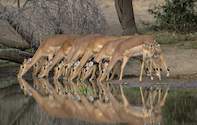
A new paper published in the Journal of Mammology may have serious implications for how scientists designate which mammals belong to which species. Authors Robert Baker and Robert Bradley present the argument that species should be recognised based on genetic data, and which genes in a species are isolated from the genes of their nearest relatives.
Using their technique, which is made possible by advances in unravelling the genetic code, they estimate that there are about 2,000 more species of mammals than have previously been recognised by taxonomists. Genetic information is especially valuable for cryptic species, where two species look very similar and can hybridise but do not actually belong to the same species.
The definition of a species that is currently used comes from a 1940s proposal from Ernst Mayr, which uses reproductive isolation. In this theory, animals are classified into species not only on the basis of their physical characteristics, but also on whether they can successfully breed together and produce offspring that are also fertile.
Baker and Bradley argue that it is not always possible to observe mating and to know whether interbreeding to create hybrid species is taking place. If their study is accepted, it will have implications for issues such as conservation and the scientific understanding of evolution.

 A guide on African mammals in Kruger National Park. This mammals of africa guide includes information on all the species of mammal that peop...
A guide on African mammals in Kruger National Park. This mammals of africa guide includes information on all the species of mammal that peop...